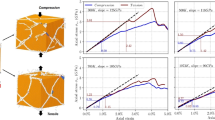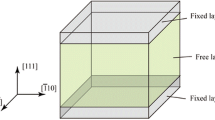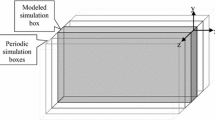Abstract
Stress–strain diagrams for a pure nickel crystal have been studied versus temperature, strain rate, and size of a simulated computational cell under shear along the 〈111〉 direction by the molecular dynamics method. Shear in the model has been simulated by displacing atoms in the upper and lower parts of the computational cell in opposite directions. During the computer experiment, these parts move as a whole. For other boundaries of the computational cell, periodic boundary conditions have been set. Interatomic interactions have been described in terms of Cleri–Rosato many-particle potentials constructed in the tight-binding approximation. It has been shown that the shear rate less than 20 m/s has a weak influence on the theoretical strength at constant temperature. As the temperature grows, dislocations and plastic deformation in perfect crystals arise at lower strains. In addition, the temperature significantly influences the slope of the stress-strain curves in the elastic region because of the temperature dependence of the shear modulus. The temperature dependences of the theoretical strength and shear modulus obtained in this study are nearly linear, which agrees with data of real experiments. The shear modulus at normal temperature is also close to the reference value. At the given loading mode (shear along the 〈111〉 direction), dislocations arise in two slip systems. At sufficiently high strains, dislocations from one slip system participate in deformation twinning. Those from the other system are stopped by these twins, which, along with grain boundaries, are known as effective barriers for moving dislocations.





Similar content being viewed by others
REFERENCES
M. A. Shtremel’, Fracture, Part 1: Fracture of Material (Metallurgiya, Moscow, 1982) [in Russian].
C. Kittel, Introduction to Solid State Physics (Wiley, New York, 1953).
J. Guo, B. Wen, R. Melnik, Sh. Yao, and T. Li, Diamond Relat. Mater. 20, 551 (2011).
T. Tachibana, H. Furuya, and M. Koizumi, J. Nucl. Sci. Technol. 13, 497 (1976).
D. Cereceda, M. Diehl, F. Roters, D. Raabe, J. M. Perlado, and J. Marian, Int. J. Plast. 78, 242 (2016).
J. Fridel, Dislocations (Pergamon, Oxford, 1964).
J. P. Hirth and J. Lothe, Theory of Dislocations (McGraw-Hill, New York, 1968).
A. D. Evstifeev, A. A. Gruzdkov, and Yu. V. Petrov, Tech. Phys. 58 (7), 989 (2013). https://doi.org/10.1134/S1063784213070086
F. Cleri and V. Rosato, Phys. Rev. B 48, 22 (1993).
C. Chen, F. Zhang, H. Xu, Z. Yang, and G. M. Poletaev, J. Mater. Sci. 57, 1833 (2022).
G. M. Poletaev, J. Exp. Theor. Phys. 133 (4), 455 (2021).
G. M. Poletaev and I. V. Zorya, J. Exp. Theor. Phys. 131 (3), 432 (2020).
G. M. Poletaev and I. V. Zorya, Tech. Phys. Lett. 46 (6), 575 (2020).
G. M. Poletaev and M. D. Starostenkov, Phys. Solid State 51 (4), 727 (2009).
K. A. Bukreeva, A. M. Iskandarov, S. V. Dmitriev, R. R. Mulyukov, and Y. Umeno, Phys. Solid State 56 (3), 423 (2014).
P.-T. Li, Y.-Q. Yang, Z. Xia, X. Luo, N. Jin, Y. Gao, and G. Liu, RSC Adv. 7, 48315 (2017).
V. S. Krasnikov, A. Y. Kuksin, A. E. Mayer, and A. V. Yanilkin, Phys. Solid State 52 (7), 1386 (2010).
F. Cardarelli, “Less common nonferrous metals,” in Materials Handbook (Springer, Cham, 2018), pp. 317–695.
Z.-H. Jin, P. Gumbsch, K. Albe, E. Ma, K. Lu, H. Gleiter, and H. Hahn, Acta Mater. 56, 1126 (2008).
M. Chassagne, M. Legros, and D. Rodney, Acta Mater. 59, 1456 (2011).
N. V. Malyar, B. Grabowski, G. Dehm, and C. Kirchlechner, Acta Mater. 161, 412 (2018).
Y. Liang, X. Yang, M. Gong, G. Liu, Q. Liu, and J. Wang, Comput. Mater. Sci. 161, 371 (2019).
Author information
Authors and Affiliations
Corresponding author
Additional information
Translated by V. Isaakyan
Rights and permissions
About this article
Cite this article
Poletaev, G.M., Ponomarenko, E.D., Podorova, D.K. et al. Molecular Dynamics Investigation of the Temperature Dependences of Nickel Theoretical Strength and Shear Modulus. Tech. Phys. 67, 597–600 (2022). https://doi.org/10.1134/S1063784222080072
Received:
Revised:
Accepted:
Published:
Issue Date:
DOI: https://doi.org/10.1134/S1063784222080072




